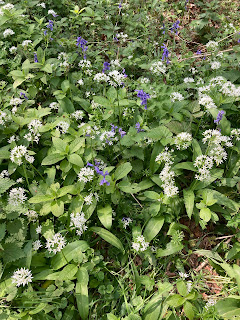A brief note- this blog is again about a field trip, and not about wildlife that can be found on campus. However, this was a field trip to Winterton Dunes, an incredible acidic dune system on the East Norfolk coast. It is home to lots of rare and unusual wildlife, for example a Little Tern colony, Natterjack toads, and Grayling butterflies, but this blog is about the exciting Cladonia lichens.
A picture of the landscape at Winterton, showing the sea in the background, and the grey dune system in the foreground.
The sand dunes at Winterton are carpeted in nationally-significant numbers of these amazing lichens. They are indicator species for grey dune habitat, which is a rare and protected habitat. These dunes are particularly interesting as they are acidic, rather than calcareous like those found on the North coast. This is more similar to the habitat types found in the Baltic region.
Embryo dunes at Winterton: embryo dunes forming around tufts of grass (L), the dune system looking inland, with the youngest dunes at the front and the mature dunes at the back (R).
Dune succession starts at the beach, where embryo dunes form. They then grow as sand builds up around an object acting as a wind break (e.g. some grass, a stone). As the dunes mature, plants colonise, making the dunes grow even larger. Eventually soil develops, and more complex plant communities develop, culminating in woodland. Cladonia lichens live in the middle section of the grey dunes, between the embryo dunes and the woodland.
A close-up photo of a Cladonia lichen, being photobombed by a Grayling caterpillar!
These lichens are quite rare, so Winterton Dunes is a nature reserve to try to protect them. However, there is risk of trampling from people and dogs, which is suspected to harm the lichens. To investigate whether paths are a risk to lichen communities, we designed an experiment to measure their distribution related to paths.
The vegetation on the grey dunes, including the lichens.
We decided to measure the percentage cover of lichens on and off paths to see if trampling was having a great impact. We placed quadrats in the centre of paths and 1.5m away from each edge at set points along paths. We defined the edge of a path as having a average sward height of >5 cm. Each sample was taken 10 paces apart (only 1 person walked this to control for different stride length). We took a total of 30 samples (1 sample = 1 centre quadrat + 2x edge quadrats) to make our experiment scientifically robust. The quadrat had 25 squares, so each square covered in lichen accounted for 4% cover, this was used to approximate average percentage cover of the measured area.
A diagram of the placement of quadrats in relation to the centre of the paths measured.
We found that the centre of paths had a significantly lower percentage cover of lichens than the edges.
Figure 1- The difference in percentage cover of lichens on the centre and the edge of paths at Winterton. The percentage cover of lichens at the edge of the paths (n = 60, μ = 56.4%) is significantly greater (t = 9.159, P < 0.01, df = 88) than the percentage cover in the centre of the paths (n = 30, μ = 2.4%). The darkest line in the box represents the mean, the edges of the box the interquartile range, and the whiskers the range.
Trampling has a significantly negative effect on lichen distribution. Therefore I would recommend that the site be managed so that lichens are less at risk. Conservation recommendations I would give include:
1. Rope off areas with particularly large cover of lichens to prevent people from walking through and disturbing them.
2. Informing the public through signs and notices about the lichens and how important they are.
3. Reducing the number of paths available to walk along (there are currently many paths that lead to the same destination), and instead prioritise a few main paths so that trampling is reduced.
If these measures are implemented, there should be continued monitoring of the lichens to ensure recovery and make sure that other factors are not negatively influencing their distribution.
Lichen identification
Two species of Cladonia lichen are present at Winterton Dunes, C. portentosa and C. arbuscula. They appear very similar on a surface level, but can be easily separated by some key identifiable features.
C. portentosa glows brightly under ultraviolet (UV) light at the base of its podetia (branching structures), fluorescing blue-white due to the presence of perlatolic acid, which is believed to increase acidity tolerance and may even have antiviral properties, with interesting implications for human medicine. It also has terminal branches that face in all directions and has a yellow-green colour due to increased exposure of its symbionts (algae that live inside it, providing it with energy from the sun).
C. arbuscula does not glow under UV light and its terminal branches all face in the same direction. It also takes on a more silvery-grey appearance than C. portentosa.
A close-up of C. arbuscula, with terminal branches all facing the same direction (to the left).











Comments
Post a Comment